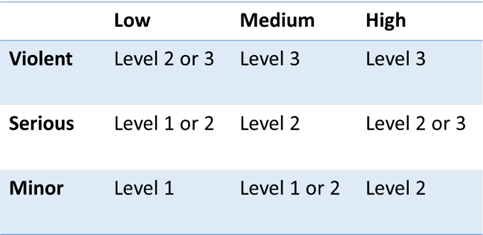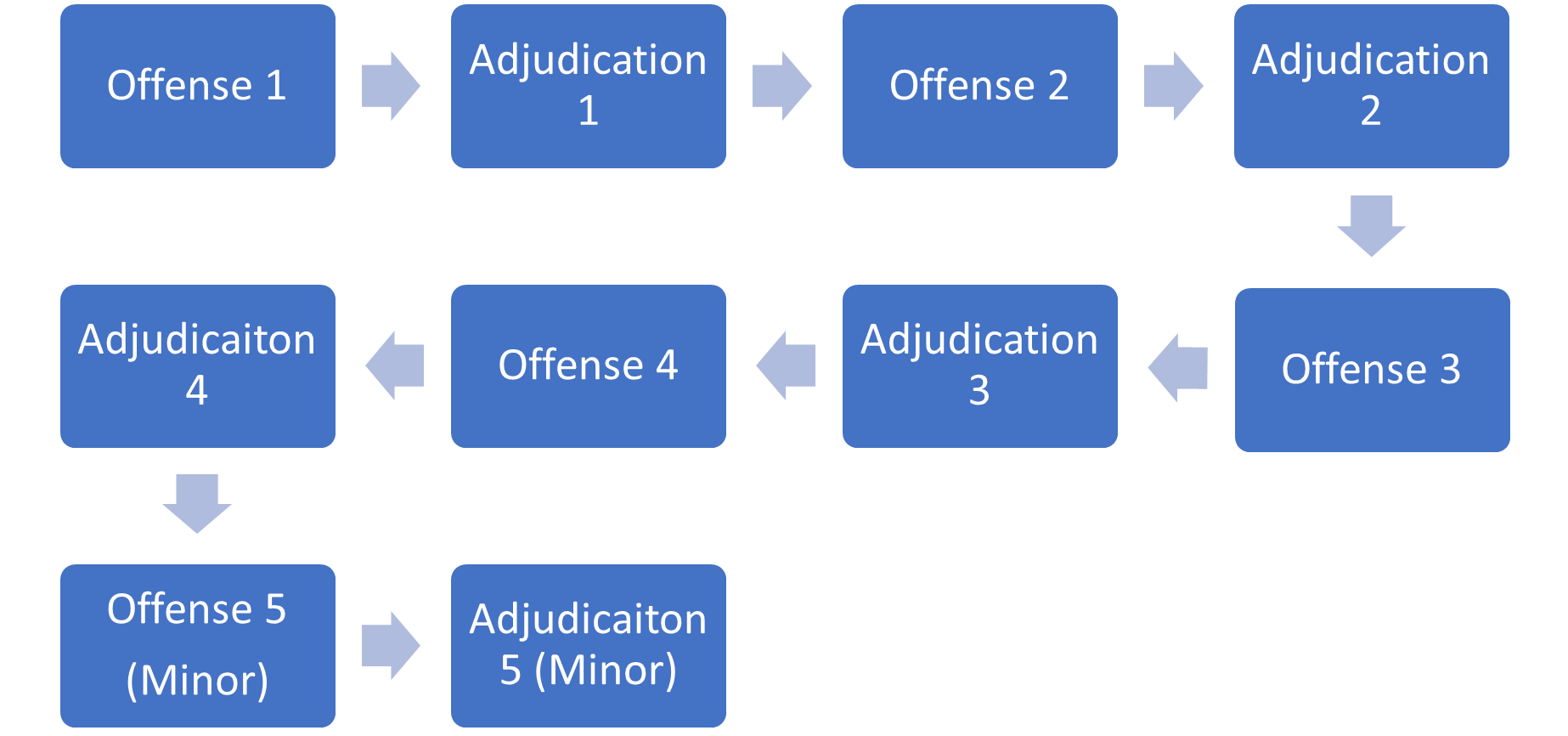
Determination of the correct disposition level available in a delinquency case requires a four-step process.
- Identify the offense for which disposition is being entered (hereinafter referred to as the “disposition offense”).
- Identify the offense classification for the disposition offense.
- Calculate the juvenile’s delinquency history level.
- Use the disposition chart to identify the corresponding level or levels for the case.
1. Identify the Disposition Offense.
One might think that this would not be difficult. A juvenile is adjudicated delinquent for a certain offense and then disposition is entered for that offense. Sometimes it is just that easy. However, many times it is more complicated.
Multiple Adjudications in During the Same Session of Court
Juveniles are sometimes adjudicated for multiple offenses during the same session of court. They may come to court for adjudication of multiple offenses related to the same event, such as disorderly conduct, assault on school personnel, and resisting a public officer that all occurred during one event at school. A juvenile may also come to court on a single day for adjudication of multiple offenses that are not related, such as charges of breaking and entering that occurred on one day and charges of common law robbery that occurred on a different day.
In either of these scenarios, when a juvenile is adjudicated for multiple offenses during the same session of court, G.S. 7B-2508(h) requires the consolidation of all adjudicated offenses for disposition and imposition of one disposition for the consolidated offenses. Under these circumstances, the disposition offense must be the most serious offense.
Multiple Adjudications During Different Sessions of Court
A juvenile may also come to court for disposition of multiple adjudications that occurred during different sessions of court. Unlike the above situations, the Juvenile Code does not provide a procedure that must be followed under this circumstance. While many courts prefer to enter disposition based on the most serious offense in this circumstance, different dispositional alternatives may be available depending on which offense is used as the disposition offense. For example, when a juvenile is first adjudicated delinquent for a Class E felony and subsequently adjudicated delinquent for a Class 1 misdemeanor, the delinquency history calculation (described more fully below) will differ depending on which offense is the disposition offense. If the Class E felony is the disposition offense, the juvenile would have zero delinquency history points. If the Class 1 misdemeanor is used as the disposition offense, the juvenile would have four delinquency history points due to the prior adjudication of the Class E felony.
Therefore, when multiple adjudications that occurred during different sessions of court are being heard together for disposition, it is beneficial to calculate the disposition level based on each adjudicated offense. This will provide the full range of dispositional options in the case. The statutory requirement to select a disposition that is designed to 1) protect the public and 2) meet the needs and best interests of the juvenile, provides a framework for choosing among the range of disposition level alternatives. G.S. 7B-2501(c). While the choice of which specific adjudication to use as the disposition offense is discretionary in this circumstance, the court must identify one disposition offense in order to comply with the disposition statutes.
A combination of these issues is also possible. A juvenile may come to disposition with both multiple adjudications in one session of court and single adjudications from different sessions of court. In this circumstance, a three-step process must be followed.
- Consolidate the offenses that occurred during the same session of court and identify the most serious offense.
- Consider the outcome when using any offenses identified in step one and any other individual adjudication that occurred during a separate session of court.
- Select the offense for which disposition will be entered from the offenses considered in step 2.
2. Identify the Offense Classification for the Disposition Offense
Once the disposition offense is identified, the offense classification for that offense must be determined. G.S. 7B-2508(a) provides this classification structure:
| Disposition Offense | Offense Classification |
| Class A – E felony | Violent |
| Class F – I felony and Class A1 misdemeanor | Serious |
| Class 1 – 3 misdemeanor or adjudication of indirect contempt | Minor |
3. Determine the Juvenile’s Delinquency History Level
Delinquency history level is determined according to the number of delinquency history points the juvenile has. Points are calculated based on prior adjudications or convictions and the probation status of the juvenile at the time the disposition offense occurred. G.S. 7B-2507(b) details points that attach to any prior adjudication or conviction.
It is first essential to determine what counts as a prior adjudication or conviction for the purpose of calculating points.
- A prior adjudication counts for points when that adjudication occurred before the adjudication of the disposition offense. G.S. 7B-2507(a). The offense dates are not relevant in this determination.
- If a juvenile was adjudicated for more than one offense during a single session of court or convicted of more than one offense in a single superior court during one calendar week, only the adjudication or conviction for the offense with the highest point total is used. G.S. 7B-2507(d).
- No points are assigned for misdemeanor Chapter 20 motor vehicle convictions other than convictions for impaired driving and misdemeanor death by vehicle. G.S. 7B-2507(2b), (3a).
- No points are assigned for direct or indirect contempt adjudications. G.S. 7B-2507(b).
Points are assigned as follows for any prior adjudication or conviction that count in the point calculation:
| Class 1, 2, or 3 misdemeanor | 1 point |
| Class F – Class I felony, Class A1 misdemeanor | 2 points |
| Conviction of impaired driving or misdemeanor death by vehicle | 2 points |
| Class A – Class E felony | 4 points |
In addition, if the juvenile was on probation at the time the disposition offense occurred, then two additional points are added to the point calculation. G.S. 7B-2507(b). It is essential to know the offense date of the disposition offense and the dates that the juvenile was on probation in order to make this determination.
Once the total points are calculated, convert the point total to a delinquency history level using this structure, provided in G.S. 7B-2507(c):
| 0 -1 point | Low |
| 2- 3 points | Medium |
| 4 or more points | High |
4. Use the Disposition Chart to Identify the Corresponding Level or Levels for the Case.
Once the offense classification in step two and the delinquency history level in step 3 are identified, the possible disposition level or levels are obtained by using the disposition chart in G.S. 7B-2508(f) and pictured below. The offense classification level runs down the left side of the chart and the delinquency history level runs across the top. The box that matches the offense classification and delinquency history level in the case dictates the disposition level or levels. The court can choose between levels when the box indicates two possible levels.
Exceptions to the Chart
There are three circumstances in which a level that is higher than the level dictated by the chart can be ordered. They are:
- When the chart dictates a level two disposition and the juvenile has previously received a level three disposition, the court can order a level three disposition. G.S. 7B-2508(d).
- A juvenile adjudicated delinquent for a minor offense may receive a level 3 disposition if that juvenile has been adjudicated delinquent for four or more prior offenses. G.S. 7B-2508(g). The definition of a prior adjudication in this context is different than the definition for counting points, described above. For this purpose, offenses count if they were committed after the adjudication of the preceding offense. Offense dates and adjudication dates are therefore essential in determining if there are four or more prior adjudications that count. The statute requires this order of events:

If this pattern is present, a level three disposition is allowed for offense 5.
- If the court finds beyond a reasonable doubt that the disposition offense was committed as part of criminal gang activity, as defined in G.S. 7B-2508.1, the court must impose a disposition that is one level higher than the disposition level dictated by the chart. G.S. 7B-2508(g1). This is an issue that must be litigated and carries constitutional law implications that are beyond the scope of this blog.
The Juvenile Code also allows for a departure down from a level three to a level two disposition when the court submits written findings on the record that substantiate extraordinary needs on the part of the juvenile. G.S. 7B-2508(e).
Dispositions Available Regardless of Level
G.S. 7B-2501(d) gives the court the authority to dismiss a case at the dispositional hearing. This can be done regardless of what is dictated by the disposition chart. This same statute also allows the court to continue the case for up to six months in order for the family to meet the needs of the juvenile. This option is also available regardless of the disposition level dictated by the disposition chart. You can find more information on this option in my previous blog, Is There a Deadline for Ordering a Disposition in a Delinquency Case?
These dispositional rules can be complicated, especially when a juvenile has multiple adjudications. As always, feel free to reach out with any questions or comments. You can reach me at greene@sog.unc.edu.


